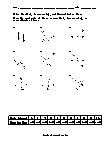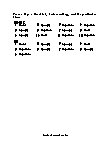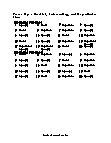Parallel, Intersecting, and Perpendicular Lines Worksheets
What are Parallel, Perpendicular, and Intersecting Lines? You probably are familiar with the term line. No, it isn't the line that requires you to stand to wait for your turn. In geometry, there are three different types of lines, namely, parallel lines, perpendicular lines, and intersecting lines. Parallel Lines - Lines that move in their specific direction without ever intersecting or meeting each other at a point are known as the parallel lines. As these never meet or intersect, the distance between also remains the same. Some real-life examples of parallel lines are the railway tracks. The rails of the track extend individually without meeting each other, and the distance between them is also unchanged. Another example is the lines drawn on a writing pad. Perpendicular Lines - Lines that meet each other at a certain point and form a right angle are known as the perpendicular lines. Some real-life examples of perpendicular lines include the tiles meeting each other at a right angle. Any arrangement that allows two lines to be set at 90 degrees are examples of perpendicular lines. Intersecting Lines - Lines that seem to cross each other or meet at a point when extended to some length are known as the intersecting lines. The point where these lines meet is known as the intersection point.
-
Basic Lesson
Guides students through parallel and intersecting lines. Intersecting lines are lines that meet at a point. When two lines intersect, they define angles at the point of intersection. Lines AB and PQ are called as intersecting lines.
View worksheet -
Intermediate Lesson
Demonstrates the application of parallel and perpendicular lines. Perpendicular lines are lines that intersect at one point and form a 90 degree angle Line AB is perpendicular to line PQ.
View worksheet -
Independent Practice 1
A really great activity for allowing students to understand the concepts of parallel, intersecting, and perpendicular lines.
View worksheet -
Independent Practice 2
Students determine whihc lines are Parallel, Intersecting, and/or Perpendicular in 20 assorted problems. The answers can be found below.
View worksheet -
Homework Worksheet
Students are provided with 12 problems on Parallel, Intersecting, and Perpendicular Lines.
View worksheet -
Skill Quiz
This tests the students ability to identify Parallel, Intersecting, and Perpendicular Lines.
View worksheet
Those Crazy Lines
Have your heard about the the parallel lines that actually
do meet?
They are very discrete.







